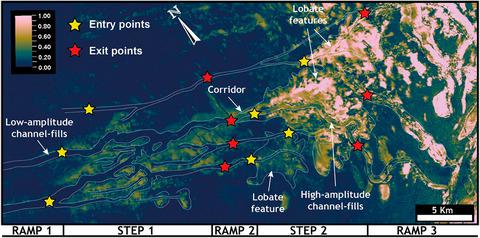当前位置:
X-MOL 学术
›
Basin Res.
›
论文详情
Our official English website, www.x-mol.net, welcomes your feedback! (Note: you will need to create a separate account there.)
Fill-and-Spill, Tilt-and-Repeat (FaSTaR) cycles: Stratigraphic evolution above a dynamic submarine stepped slope
Basin Research ( IF 3.2 ) Pub Date : 2022-07-26 , DOI: 10.1111/bre.12700 Junia Casagrande 1, 2 , David M. Hodgson 1 , Jeff Peakall 1 , Pedro Monteiro Benac 2
Basin Research ( IF 3.2 ) Pub Date : 2022-07-26 , DOI: 10.1111/bre.12700 Junia Casagrande 1, 2 , David M. Hodgson 1 , Jeff Peakall 1 , Pedro Monteiro Benac 2
Affiliation

|
The classic fill-and-spill model is widely applied to interpret topographic controls on depositional architecture and facies distributions in slope successions with complicated topography. However, this model implies a constant topographic configuration over the lifespan of a turbidite system. In contrast, the impact on patterns of erosion and deposition above dynamic slopes whose topographic configuration varies spatially over time remains poorly investigated. Here, using high-resolution 3D seismic reflection data and more than 100 wells from a 40 km long stepped slope system (Campos Basin, offshore Brazil), we document the evolution of a sand-prone turbidite system active during the Oligocene–Miocene transition. This turbidite system was influenced by vertical and lateral deformation, and we propose a new stratigraphic model to explain the resultant depositional architecture. Two depocentres were identified as steps, with channels on the proximal step, and channel–lobe complexes on the distal step, bounded by sediment bypass-dominated ramps. Lateral stepping of channels on the proximal step, and oblique stacking of the down-dip lobe complexes, each cut by through-going channels, indicate multiple fill-and-spill cycles. A persistent north-east-ward stepping and thickening on the steps are interpreted to reflect lateral tilting of the seafloor driven by salt tectonics. The dynamic substrate prevented the establishment of a single long-lived conduit across the proximal step, as recorded in systems with fixed topographic configurations. The filling of through-going channels with mud at the end of each cycle suggests waxing-to-waning sediment supply cycles and periods of sand starvation when the lateral tilting dominated and drove avulsion of the feeder channels towards topographic lows. This study demonstrates that subtle dynamic slope deformation punctuated by discrete sediment supply cycles results in complex stratigraphic patterns with multiple phases, and multiple entry and exit points. Repeated cycles of fill-and-spill, tilt-and-repeat are likely to be present in other stepped slope systems.
中文翻译:

Fill-and-Spill, Tilt-and-Repeat (FaSTaR) 循环:动态海底阶梯斜坡上方的地层演化
经典的填溢溢流模型被广泛应用于解释复杂地形斜坡序列中沉积构造和相分布的地形控制。然而,该模型暗示在浊积岩系统的整个生命周期内具有恒定的地形配置。相比之下,对地形配置随时间发生空间变化的动态斜坡上方侵蚀和沉积模式的影响仍缺乏研究。在这里,我们使用高分辨率 3D 地震反射数据和来自 40 公里长阶梯斜坡系统(巴西近海坎波斯盆地)的 100 多口井,记录了在渐新世-中新世过渡期间活跃的易出砂浊积岩系统的演化。该浊积岩系统受垂直和横向变形的影响,我们提出了一个新的地层模型来解释由此产生的沉积结构。两个沉积中心被确定为阶梯,近端阶梯上有通道,远端阶梯上有通道-波瓣复合体,以沉积物旁路为主的坡道为界。近端台阶上通道的横向步进和下倾波瓣复合体的倾斜堆叠,每个通道都被直通通道切割,表明多个填充和溢出循环。持续的东北向台阶和台阶上的增厚被解释为反映了盐构造驱动的海底横向倾斜。正如在具有固定地形配置的系统中所记录的那样,动态基板阻止了跨近端台阶建立单个长寿命管道。在每个周期结束时用泥浆填充直通通道表明当侧向倾斜占主导地位并推动支线通道向地形低点撕裂时,沉积物供应周期由长到短,以及沙子匮乏期。这项研究表明,由离散的沉积物供应循环打断的细微动态斜坡变形导致具有多个阶段和多个入口和出口点的复杂地层模式。填充和溢出、倾斜和重复的重复循环很可能出现在其他阶梯式斜坡系统中。这项研究表明,由离散的沉积物供应循环打断的细微动态斜坡变形导致具有多个阶段和多个入口和出口点的复杂地层模式。填充和溢出、倾斜和重复的重复循环很可能出现在其他阶梯式斜坡系统中。这项研究表明,由离散的沉积物供应循环打断的细微动态斜坡变形导致具有多个阶段和多个入口和出口点的复杂地层模式。填充和溢出、倾斜和重复的重复循环很可能出现在其他阶梯式斜坡系统中。
更新日期:2022-07-26
中文翻译:

Fill-and-Spill, Tilt-and-Repeat (FaSTaR) 循环:动态海底阶梯斜坡上方的地层演化
经典的填溢溢流模型被广泛应用于解释复杂地形斜坡序列中沉积构造和相分布的地形控制。然而,该模型暗示在浊积岩系统的整个生命周期内具有恒定的地形配置。相比之下,对地形配置随时间发生空间变化的动态斜坡上方侵蚀和沉积模式的影响仍缺乏研究。在这里,我们使用高分辨率 3D 地震反射数据和来自 40 公里长阶梯斜坡系统(巴西近海坎波斯盆地)的 100 多口井,记录了在渐新世-中新世过渡期间活跃的易出砂浊积岩系统的演化。该浊积岩系统受垂直和横向变形的影响,我们提出了一个新的地层模型来解释由此产生的沉积结构。两个沉积中心被确定为阶梯,近端阶梯上有通道,远端阶梯上有通道-波瓣复合体,以沉积物旁路为主的坡道为界。近端台阶上通道的横向步进和下倾波瓣复合体的倾斜堆叠,每个通道都被直通通道切割,表明多个填充和溢出循环。持续的东北向台阶和台阶上的增厚被解释为反映了盐构造驱动的海底横向倾斜。正如在具有固定地形配置的系统中所记录的那样,动态基板阻止了跨近端台阶建立单个长寿命管道。在每个周期结束时用泥浆填充直通通道表明当侧向倾斜占主导地位并推动支线通道向地形低点撕裂时,沉积物供应周期由长到短,以及沙子匮乏期。这项研究表明,由离散的沉积物供应循环打断的细微动态斜坡变形导致具有多个阶段和多个入口和出口点的复杂地层模式。填充和溢出、倾斜和重复的重复循环很可能出现在其他阶梯式斜坡系统中。这项研究表明,由离散的沉积物供应循环打断的细微动态斜坡变形导致具有多个阶段和多个入口和出口点的复杂地层模式。填充和溢出、倾斜和重复的重复循环很可能出现在其他阶梯式斜坡系统中。这项研究表明,由离散的沉积物供应循环打断的细微动态斜坡变形导致具有多个阶段和多个入口和出口点的复杂地层模式。填充和溢出、倾斜和重复的重复循环很可能出现在其他阶梯式斜坡系统中。


























 京公网安备 11010802027423号
京公网安备 11010802027423号